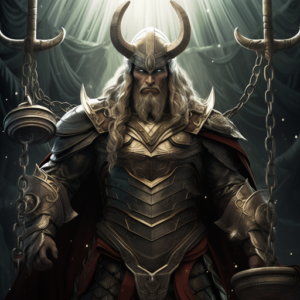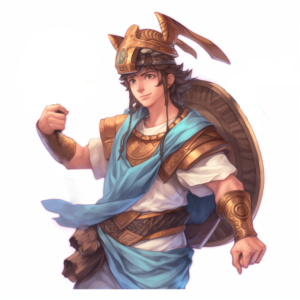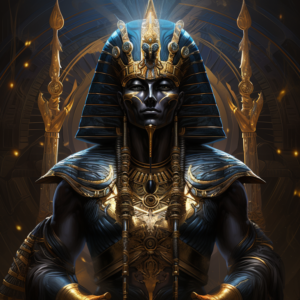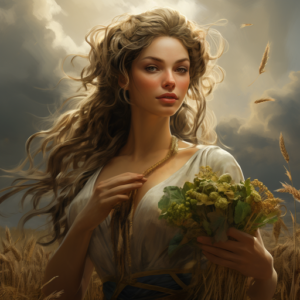Gefjun, also spelled as Gefjon or Gefion, is a goddess associated with fertility, agriculture, and possibly also with the island of Zealand in modern-day Denmark. Her most well-known myth involves the creation of the island of Zealand itself.
According to the myth, Gefjun was a powerful goddess who had the ability to plow land and increase its fertility. The king of Sweden, Gylfi, promised her as much land as she could plow in one night. Gefjun then transformed her four sons into oxen and attached them to a plow. She managed to plow a substantial piece of land, which tore away from Sweden and became the island of Zealand (Sjælland in Danish), which is a part of present-day Denmark. This myth explains the origins of the island and its fertile soil.
Appearance
Since Gefjun is associated with fertility and agriculture, she is sometimes depicted in art and illustrations as a young woman holding a plow or with symbols of agriculture, such as sheaves of grain or baskets of produce. She may be shown as a strong and powerful figure, reflecting her role in shaping the land and her connection to the earth.
Family
In the myth where Gefjun plows the land to create the island of Zealand, she transforms her four sons into oxen to assist her in the task. The names and identities of these sons are not always provided in the surviving sources.
In some versions of Norse mythology, it’s suggested that Loki is the father of Gefjun’s sons (the transformed oxen).
Symbols
There is not a singular universal symbol associated exclusively with Gefjun in the same way that some mythological figures have.
Powers & Duties
Gefjun is primarily known for her ability to plow and cultivate the land. Her most famous myth involves using her powers to plow the land and create the island of Zealand. In the myth of creating Zealand, Gefjun transforms her four sons into oxen to use them for plowing. This ability to transform and shape beings is a testament to her supernatural nature and her control over the land and its resources.
Gefjun’s myth involves the physical act of shaping and altering the landscape, demonstrating her power over the land itself. This could be seen as a form of earth manipulation or terraforming.
As a goddess of fertility and agriculture, Gefjun is associated with the concept of abundance and prosperity.
Worship
In Norse mythology, specific details about Gefjun worship is not extensively detailed in surviving sources.
Facts About Gefjun
- Gefjun was also invoked by women seeking fertility and aid in childbirth. Unmarried girls would make offerings to her, hoping for assistance in finding suitable husbands.
- Gefjun is considered one of the Aesir, the principal group of Norse deities that includes gods like Odin and Thor.
- The Giver Stone (Gefionstenen) in Copenhagen, Denmark, is associated with Gefjun. The stone depicts the goddess and her oxen and is said to commemorate the myth of the creation of Zealand.
- Gefjun and her connection to the creation of Zealand have become an important part of Danish cultural identity. The myth is often referenced in literature, art, and national symbols.
- Gefjun’s legacy continues to be felt in modern times. In Copenhagen, there’s a Gefjun Fountain that features her and her oxen. Additionally, the myth of Zealand’s creation has inspired various creative works.
*As an Amazon Associate I earn from qualifying purchases.






